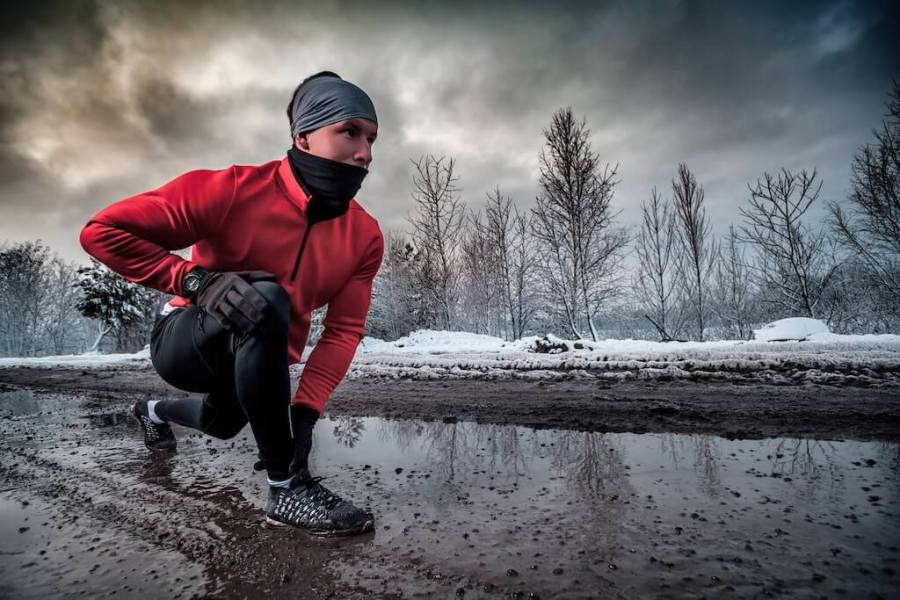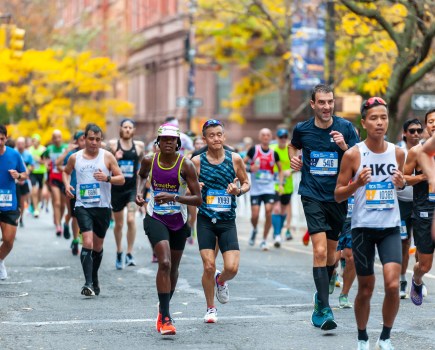In this guide we’ll explain all you need to know about how to run outside in winter, with expert input from Olympians, coaches and nutritionists. Get ready to embrace the cold!
As long as you’re mentally and physically prepared – with the right kit, running headphones and some of the best moisture-wicking underwear – running in winter can be both highly rewarding and beneficial to your fitness routine.
The benefits of running outside in winter are simply too positive to ignore. Studies comparing indoor versus outdoor activity highlight that ‘green’ exercising in nature creates more positive engagement and improves self-esteem, revitalization and negative moods, such as stress and depression. Research also found that the cold actives brown fat, which “burns chemical energy to create heat and help maintain body temperature” (and burns off the unwanted white body fat), meaning cold runs could result in a higher calorie burn.
How to run outside in winter
1. Adapt your mindset
Running outside on a cold, miserable day might not be your idea of fun. However, there’s a mindset change required to complete the challenge. Roger Black MBE, GB Olympian and founder of Roger Black Fitness, simply says, don’t overthink it.
“As a morning run is part of my daily routine,” he says, “I ‘just do it’, in the wise words of a global footwear brand.”
Accept that you may not achieve your perfect form or PB, but the feeling of achievement might be enough to get you hooked.
“Acknowledge and accept that the first 15 minutes of your run may be uncomfortable,” says Black. “But thereafter, your body should warm up and feel good as you enter your ‘flow’. Perhaps the greatest benefit is a sense of accomplishment once you finish. Focus on how good you will feel when it’s over rather than how hard it might be.”
2. Warm-up properly
Heading straight into the cold can risk injury, as muscles are less flexible and more prone to injury. Instead, consider your preparation before you leave the house.
Lucy Campbell, CrossFit athlete, coach and Fittest Woman in the UK 2022, has this to say:
“During cold months, the body tries to conserve heat and sends more blood to organs in your body’s midsection, such as your heart, lungs and digestive organs. As a result, less blood is sent to your legs, knees, arms, shoulders and other joints. This reduced blood flow makes the blood vessels at the joints constrict, leading to stiffness in these areas.”
Campbell suggests the following dynamic stretches:
- Leg swings and arm swings
- Arm circles and hip circles to improve joint mobility
- Bodyweight squats
- Jumping jacks
- High knees
- Tri-planar lunges (a three-position lunge, forward, lateral and rotational) to prime legs and glutes
- Butt kicks
3. Incorporate specific running exercises
Brent Fikowski, CrossFit Games athlete and previous 2nd Fittest Man in the World, suggests incorporating specific running exercises into your warm-up to prime your muscles and fully prepare. These could include floor sweeps: “Place one foot in front of the other in a split stance deadlift and hinge your hips back to reach to the ground.”
He says A and B skips, “will get your lower body primed and your arms moving in tandem.”
It’s also important to warm up your calves: “Do some calf raises with a bent knee, calf raises with a locked knee, then walk back and forth, putting weight on all different parts of your feet. Walk on your tip-toes, heels, sides of your feet, etc.”
4. Prepare your shins
Fikowski says shin splits can be overlooked in the cold: “You often shorten your stride for fear of slipping, and this change in technique can cause sore shins. Get ahead by doing some bodyweight tibialis raises with your back against the wall. Try 4 sets of 20 reps the day before your run.”
5. Plan your route
Although route spontaneity might be tempting, there’s a risk of ice, snow, darkness and slippery patches in the winter. So, plan a route carefully to remain safe.
“Slipping and falling can result in rolling an ankle or bruises, but you can also pull your groin or a hamstring,” says Fikowski. “In the winter, we often sit more often, increasing tightness in those areas, so spend a little extra time in your warm-up to lengthen these muscles.”
And be prepared for the potential of falls by taking your mobile phone, running with a friend, and slowing down if it’s icy or dark.
6. Get your kit on
What you wear outside on your winter run is vital for optimal performance and safety. Layers provide warmth, flexibility and protection.
“For winter running,” says Roger Black, “I recommend layering breathable fabrics rather than wearing one thick fleece. Wear extra layers if it’s cold outside, but always remember that once you get going, your body temperature will rise, so don’t overdo clothing – too many clothes may also slow you down, cause chafing and be cumbersome. Consider, too, that your body loses most heat through your extremities, so invest in a hat and gloves, fit-for-purpose.”
Campell suggests a moisture-wicking baselayer or compression top: “You can invest in some fleece-lined running tights which are warm and breathable. A hat or headband is also essential as a lot of heat is lost through your head. Compression gear can help with muscle support and circulation, especially when it might be reduced in low temperatures.”
Get your hands on this excellent value set of baselayers

7. Assess your footwear
Take the winter as an opportunity to check your running shoes to see if you need to invest in something new and whether trail shoes might be necessary.
“You don’t necessarily need to change your regular trainers,” says Black, “although do be mindful of the level of traction. If your feet get cold, layer socks, as you might when running a marathon or similar.”
8. Recover right
When it’s cold outside and you stop running, your body temperature plummets, so an effective warm-down is essential.
“Finish by running slower to gradually bring your heart rate down,” says Campbell. “I’d recommend changing out of wet clothes if you’ve sweated a lot; that will help you avoid drastic drops in body temperature.”
9. Make sure you hydrate
According to nutritional therapist Lauren Windas, it can feel harder to tune into your thirst and sweat cues during the colder months, and you might not drink as much. But don’t neglect hydration, as you still lose fluids. Windas says sweat can evaporate more quickly in cold air, so we’re tricked into thinking we aren’t losing fluids.
“Drink 500ml fluid two hours before a run (water or a sports drink containing carbohydrates),” she advises, “then another 150ml just before. The best way to test if you are sufficiently hydrated before running is to check the colour of your urine (aim for a pale colour).
“After a run, I recommend isotonic sports drinks, which combine electrolytes and carbohydrates.”
She suggests aiming to drink 1.5 times the amount of fluid you lose (and will continue to lose through sweating and urination after a session) and spread your fluid intake over 2-6 hours.
10. Plan pre- and post-run nutrition
Preparing for a run with food and drink options can feel easier in the summer. However, food prep is essential to stay healthy and aid fitness and recovery.
“Winter nutrition for runners should focus on in-season produce, as eating seasonally provides various benefits. Build your plate with sweet potatoes, squash, carrots, and brussels, which provide vitamins A and C to support the immune system,” says Windas.
“Hot liquids and warm carbohydrate meals help increase body temperature and restore energy sources burned during your runs.”
Related content:







